|
Limitar tu búsqueda
[+–] Compilador o editor
- Aguilera, Nelly (6)
- Durán, Luis (4)
- Garro, Nora (1)
- Hernández Sánchez, José Antonio (1)
- Martínez, Gabriel (3)
- Meléndez, Jorge (1)
- Reyes Godelmann, Iker (1)
- Suárez, Rosa María (1)
- Svenson, Hans (1)
- Valencia, Anel (1)
[+–] Editorial
[+–] Fecha
[+–] Formato
[+–] Idioma
[+–] Tipo de documento
[+–] Tipo de recurso
[+–] Classification
|

|
|
¿Tienen algún efecto los choques en la persistencia de la pobreza? Evidencia usando trayectorias del bienestar en Nicaragua
Los choques suelen asociarse principalmente con movilidad descendente o con movimientos cíclicos de corto plazo en los cuales se entra y sale de la pobreza. Sin embargo, es probable que los hogares que se encuentran en la parte inferior de la distribución del bienestar sean aquellos que tienen mayores limitaciones para acceder a mecanismos de aseguramiento. En este estudio, consideramos si los...
|
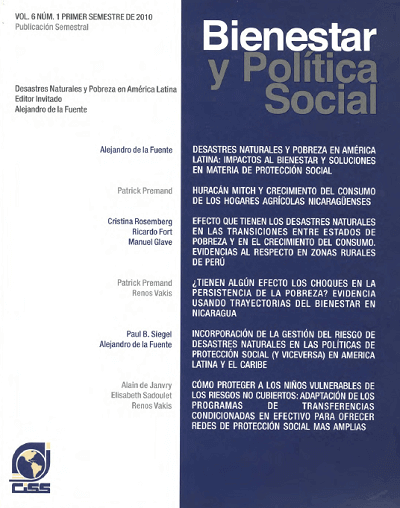
|
|
|
|

|
|
Efecto que tienen los desastres naturales en las transiciones entre los estados de pobreza y en el crecimiento del consumo. Evidencias al respecto en zonas rurales de Perú
Los desastres naturales, fenómeno que cada día adquiere mayor importancia, tienen un efecto directo a nivel regional y a nivel hogar. La creciente incidencia y persistencia de los eventos naturales está fuertemente relacionada con un mayor nivel de vulnerabilidad de los hogares y las comunidades de países en desarrollo. Los anteriores niveles de vulnerabilidad socioeconómica pueden exacerbar el...
|
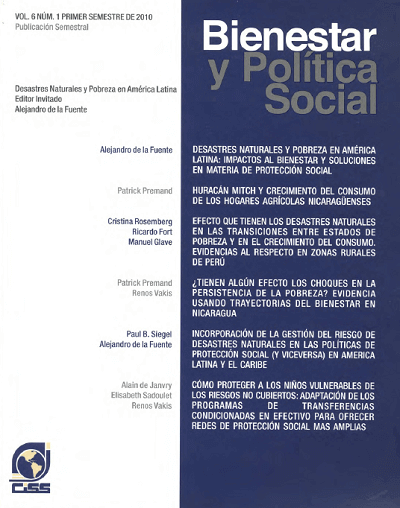
|
|
|
|

|
|
Análisis del uso de servicios financieros por parte de las empresas en México: ¿Qué nos dice el Censo Económico 2009?
Se presenta un análisis descriptivo de los resultados del Censo Económico 2009 acerca del uso de créditos y cuentas bancarias entre empresas. Para ello, se le solicitó al INEGI una serie de estadísticas sobre diversas características de las empresas que resultan relevantes en las decisiones de oferta de servicios bancarios. Esta información se solicitó agrupada según diversos segmentos por tamaño...
|

|
|
|
|

|
|
Reseña del libro. New structural economics de Justin Yifu Lin
La crisis financiera internacional detonada en 2008-2009, sus repercusiones en la actividad económica y la divergencia en las respuestas para hacerle frente han dado nueva fuerza al debate entre académicos, representantes de organismos internacionales y funcionarios públicos sobre el alcance de las políticas públicas, tanto para reducir los impactos adversos de los choques externos como para...
|

|
|
|
|

|
|
Book review. Violence and social orders: a conceptual framework for interpreting recorded human history, by Douglas C. North, John Joseph Wallis, and Barry R. Weingast
Why societies differ in their level of violence? This is the question addressed by North, Wallis, and Weingast. To provide an answer they must develop a rich theory of how individuals and organizations that compose a human group voluntarily surrender their will to act violently in exchange for participating in a society with improved conditions for the creation and conservation of wealth.
|
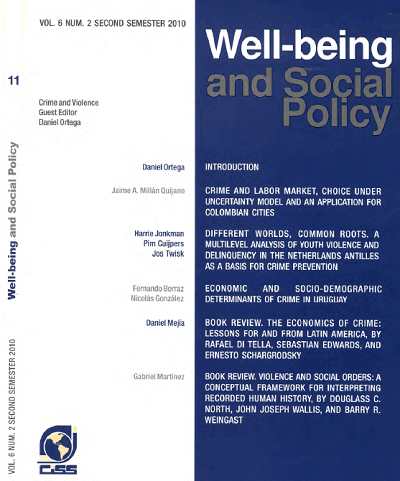
|
|
|
|

|
|
The Americas Social Security Report 2005: labor markets and the fragmentation of social insurance, financing for HIV-AIDS by social security (Book review)
The Americas Social Security Report 2005, published by the CISS, gathers the contributions, opinions, and comments of more than 30 social security specialists from different countries in the American continent, as well as the review of the most recent literature on this matter. The purpose is to present, to specialized public and to laymen, a detailed, analytic, and updated report of the...
|

|
|
|
|

|
|
Book review. The economics of crime: lessons for and from Latina America, by Rafael Di Tella, Sebastian Edwards, and Ernesto Schargrodsky
The Economics of Crime: Lessons for and from Latin America makes an important contribution to the study of crime and violence in Latin America and to the debate about what works for reducing crime (and at what cost?). As the title of the book correctly suggests, the book brings together contributions from Latin American economists on the determinants and consequences of crime, as well as...
|
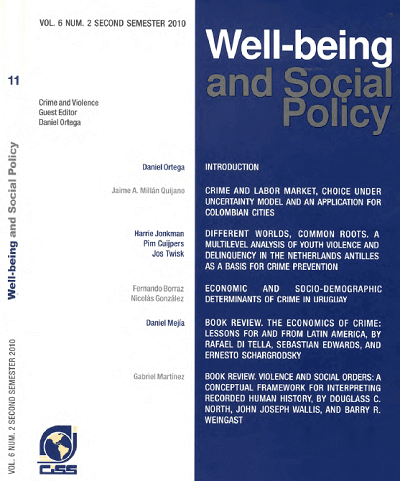
|
|
|
|

|
|
Economic and socio-demographic determinants of crime in Uruguay
This study estimates a panel data model to analyze the economic and socio-demographic determinants of crime in Uruguay across the 19 Uruguayan departments in the period 1986-2006.
This research has two components: i) to present a systematic analysis of the Uruguayan crime data and socio-economic and demographic characteristics of the population, and ii) to evaluate the empirical significance...
|
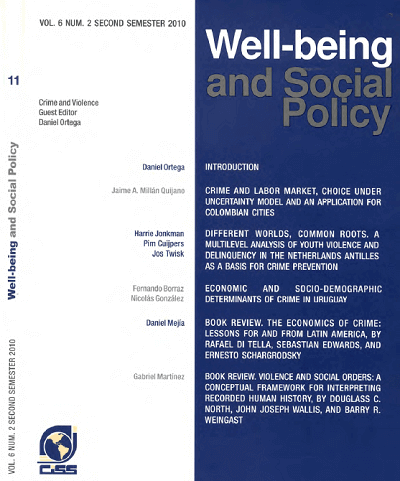
|
|
|
|

|
|
Different worlds, common roots a multilevel analysis of youth violence and delinquency in the netherlands antilles as a basis for crime prevention
Most research on the prevalence, determinants, and variations of violence and delinquency among youngsters is conducted in Western societies. This multilevel study is set in the Netherlands Antilles (NA) and aims to build up prognostic multilevel models as a basis for targeted crime prevention in a non-western area. Data were collected from a sample of adolescente in the NA. Non-hierarchical and...
|
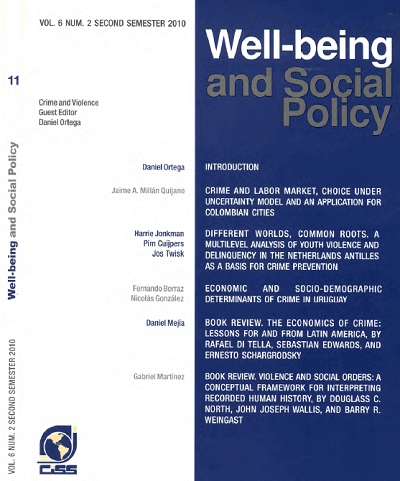
|
|
|
|

|
|
Crime and labor market, choice under uncertainty model and an application for colombian cities
Este trabajo ofrece un modelo para determinar la función de oferta del crimen con base en la teoría de la elección en condiciones de incertidumbre. Con base en el problema de un agente que maximiza su utilidad sujeto a las restricciones del mercado legal e ilegal, este estudio intenta explicar la oferta de la delincuencia como función de la distribución de los salarios y el equivalente cierto de...
|
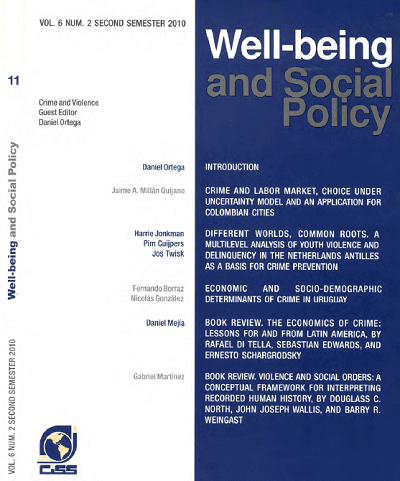
|
|
|
|

|
|
Introduction (On the studies presented at the International Conference on "Delinquency and Violence in Latin America and the Caribbean")
Crime has become the leading concern for citizens of the region and has been pushed to the forefront of the international policy agenda; what is more, the combination of very few success stories and abundant failures in curbing crime and violence has underscored how thin our understanding is and the difficulty of designing and implementing an effective strategy at the local level. This issue...
|

|
|
|
|

|
|
An investigation into the cost of universal health coverage in Mexico
The Mexican social security system, after operating for over six decades, has managed to provide healthcare for slightly over half the resident population.
There are wide geographical and socioeconomic variations in coverage. To provide wider coverage, the Federal Government created the Sistema de Protección Social en Salud (SPSS) for covering low income family. It becomes the third...
|

|
|
|
|

|
|
Is international migration a substitute for social security
The focus on short-term macroeconomic factors, including unemployment and wages, is insufficient to explain international migration. Institutional factors, bound to change only in the long run, can potentially have a large impact on migration flows. To illustrate this, we analyze Mexico-U.S. migration focusing on social security coverage, an important indicator of job formality. Using...
|
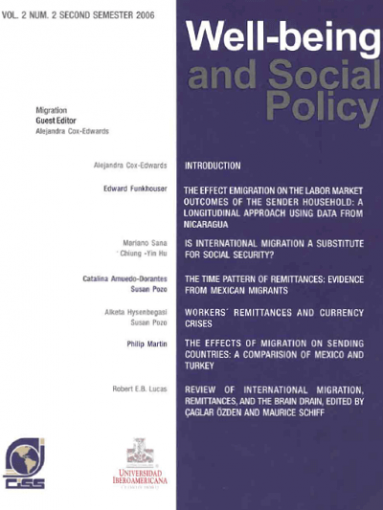
|
|
|
|

|
|
The effect of migration on the labor market outcomes of the sender household: a longitudinal approach using data from Nicaragua
In this paper, I use longitudinal data from the 1998 and 2001 Living Standard Measurement Surveys in Nicaragua to examine the impact of the emigration of household members on the household labor market integration and poverty. The main findings of the paper are that households from which an emigrant left had a reduction in members, a reduction in working members, a reduction in labor income than...
|
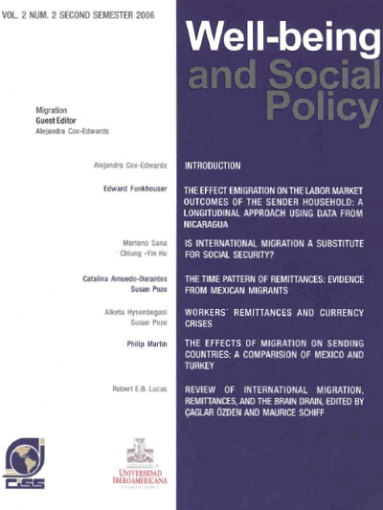
|
|
|
|

|
|
Family health expanditure and demand: an analysis based on the consumer expenditure survey - POF - 2002/2003
This paper aims at analyzing healthcare expenditure and demand of families, by estimating income-elasticity and price-elasticity for ten groups of products using the so-called model Linear Almost Ideal Demand System (LAIDS). The 2002/03 consumer expenditure surveys (POF) of the Fundação Instituto Brasileiro de Geografia e Estatística – FIBGE (Brazilian census bureau) are used, providing extremely...
|
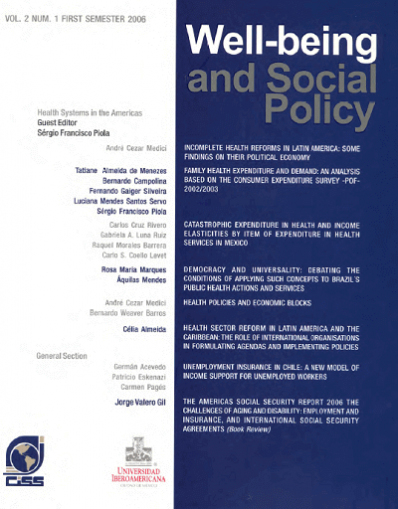
|
|
|
|

|
|
Incomplete health reforms in Latin America: some findings on their political economy
This paper raises the point that only few health reforms implemented in Latin American countries modified the existing health systems in order to fix the problems brought by the institutional fragmentation typical of this sector. A great part of these reforms did not implemented the necessary measures to improve coordination among health systems in the prevailing pluralistic model and besides,...
|

|
|
|
|

|
|
Seguro social de salud
El gobierno de México definió entre los años noventa y los dos mil principios de reforma a los seguros de salud e intentó implementarlos. Las principales iniciativas aprobadas definieron esquemas voluntarios, en un caso basado en aseguradoras privadas (que tienen muy baja penetración), y en otro, en una nueva instancia pública que funciona como mecanismo de distribución del gasto federal hacia...
|
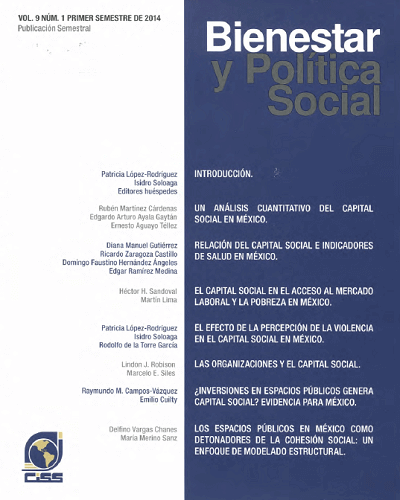
|
|
|
|

|
|
Introducción (sobre el tema de capital social que se aborda el presente número de la revista)
En las últimas décadas ha habido un creciente interés por identificar, estimar y relacionar el capital social con diversas variables del bienestar, donde la producción de beneficios o cierto rendimiento es clave. Esta actividad ha implicado la confluencia de diferentes disciplinas como la economía, la sociología, la antropología, la psicología, entre otras. A pesar de que no hay un consenso que...
|
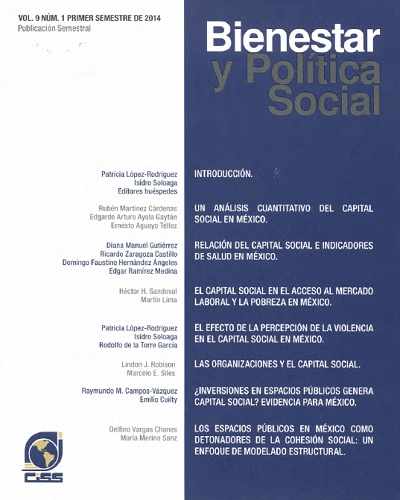
|
|
|
|

|
|
Programas de pensiones, empleo y familia
Los programas de pensiones, empleo y familia constituyen tres de las cuatro grandes categorías de la política social (la cuarta siendo los de salud). En este artículo se analizan opciones para su diseño dentro de un marco de universalidad de la seguridad social en México. Si bien estos programas tienen componentes de beneficios monetarios centrales, también requieren de estrategias sólidas y...
|
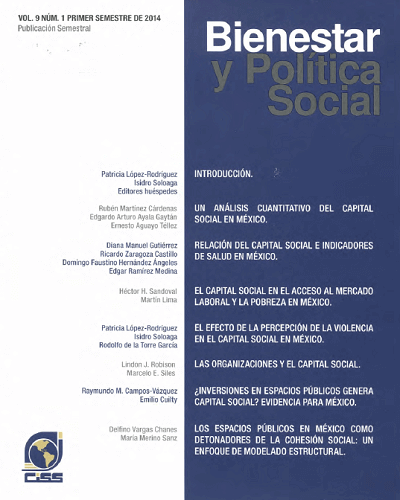
|
|
|
|

|
|
Seguridad social universal centrada en el ciudadano
Este ensayo revisa la situación de la protección social en México, así como diversas propuestas y opciones para su reforma. Una guía es el concepto de piso de protección social que han definido la Organización Internacional del Trabajo y la Organización Mundial de la Salud. Se tratan temas de forma más general bajo los grandes apartados de programas de familia, pensiones, salud y empleo, así como...
|
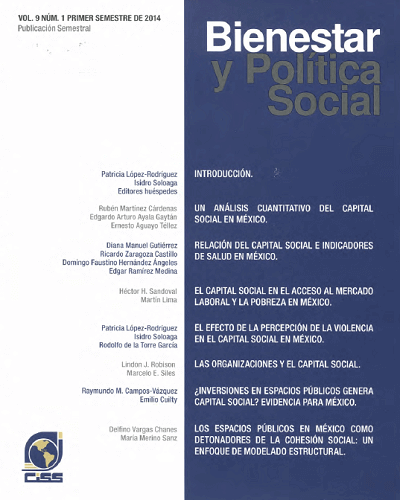
|
|
|
|
|